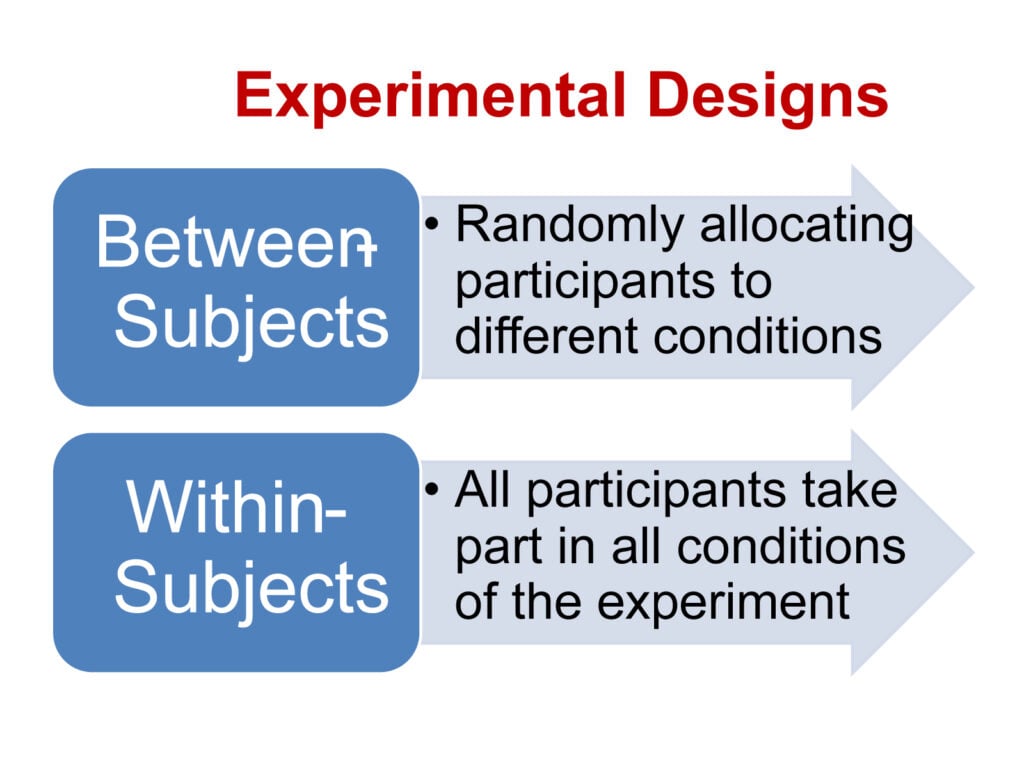In a within-subject design, each participant experiences all experimental conditions, whereas, in a between-subject design, different participants are assigned to each condition, with each experiencing only one condition.

Within-subjects (or repeated-measures) is an experimental design in which all study participants are exposed to the same treatments or independent variable conditions.
In within-subjects studies, the participants are compared to one another, so there is no control group. The data comparison occurs within the group of study participants, and each participant serves as their own baseline.
In a between-subjects design (or between-groups, independent measures), the study participants are divided into groups, and each group is exposed to one treatment or condition.
Each participant is only assigned to a single treatment. This should be done by random allocation, ensuring that each participant has an equal chance of being assigned to one group.
The differences between the two groups are then compared to a control group that does not receive any treatment. The groups that undergo a treatment or condition are typically called the experimental groups.
To recap:
- In a within-subjects design, all participants receive every treatment.
- In a between-subjects design, participants only receive one treatment.
Design Similarities
- Both types of study designs tend to be used to assess the impact of a treatment or condition on a given study population.
- The goal of both types of studies is to compare several test conditions in a single study.
- Both within-subjects designs and between-subjects designs have a group of subjects that serve as study participants and are exposed to a given treatment.
- Both experimental designs are utilized in quantitative studies and aim to result in findings that are statistically likely to generalize to a whole population.
- Between-subjects and within-subjects design both have an independent variable that is manipulated or controlled by the study’s investigators and a dependent variable that is measured.
- Random assignment is essential for both types of designs.
Design Differences
- In a within-subjects design, all participants receive all treatments. In a between-subjects design, participants receive only one treatment.
- In a within-subjects design, the participants are compared to each other, so there is no control group. In a between-subjects design, there is a control group that doesn’t receive any treatment and serves as a source of comparison for the treatment groups.
- Between-subjects designs require significantly more participants than within-subjects designs in order to detect a statistically significant difference between the two conditions.
In within-subjects designs, on the other hand, fewer participants are required as each participant provides a data point for each level of the independent variable.
A similar experiment in a between-subject design would require twice as many participants as a within-subject design. This means that they also require more resources and funding to recruit a larger sample, administer sessions, and cover costs. - Between-subjects designs tend to be easier and quicker to administer as each participant is only given one treatment. In contrast, within-subjects designs take longer to implement because every participant is given multiple treatments.
- Within-subjects designs are vulnerable to fatigue and carryover effects. Participant fatigue occurs when participants become tired, bored, or unmotivated after taking part in multiple treatments in a row.
Carryover effects are when the act of having participants take part in one condition impacts the performance or behavior on all other conditions. With between-subjects design, though, participants are exposed to fewer conditions, so fatigue and carryover effects are less of a challenge. - Because different participants provide data for each condition in between-subjects designs, individual differences among participants may threaten internal validity.
Within-subjects designs are less affected by individual differences among participants because the participants are compared to themselves and thus higher statistical power can be achieved.
FAQs
What is a 2×2 within subject design?
A 2×2 within-subjects design is one in which there are two independent variables each having two different levels. This design allows researchers to understand the effects of two independent variables (each with two levels) on a single dependent variable.
When would you use a within-subjects design?
You typically would use a within-subjects design when you want to investigate a causal or correlational relationship between variables with a relatively small sample.
The primary goal of a within-subjects design is to determine if one treatment condition is more effective than another.
Within-subjects are typically used for longitudinal studies or observational studies conducted over an extended period.
When should a within-subjects design not be used?
A within-subjects design should not be used if researchers are concerned about the potential interferences of practice effects.
If the researcher is interested in treatment effects under minimum practice, the within-subjects design is inappropriate because subjects are providing data for two of the three treatments under more than minimum practice.
When should you use a between-subjects design?
Between-subjects designs are used when you have multiple independent variables. This type of design enables researchers to determine if one treatment condition is superior to another.
A between-subjects design is also useful when you want to compare groups that differ on a key characteristic.
This key characteristic would be the independent variable, with varying levels of the characteristic differentiating the groups from each other.
When can a between-subjects design not be used?
Between-subjects cannot be used with small sample sizes because they will not be statistically powerful enough.
Between-subjects studies require at least twice as many participants as a within-subject design, which also means twice the cost and resources. When funding is limited, between-subjects design can likely not be used.
Can I use a within- and between-subjects design in the same study?
Yes. Between-subjects and within-subjects designs can be combined in a single study when you have two or more independent variables (a factorial design).
Factorial designs are a type of experiment where multiple independent variables are tested.
Each level of one independent variable (a factor) is combined with each level of every other independent variable to produce different conditions.
Is between-subjects or within-subjects design more powerful?
Within-subjects designs have more statistical power due to the lack of variation between the individuals in the study because participants are compared to themselves.
A between-subjects design would require a large participant pool in order to reach a similar level of statistical significance as a within-subjects design.

